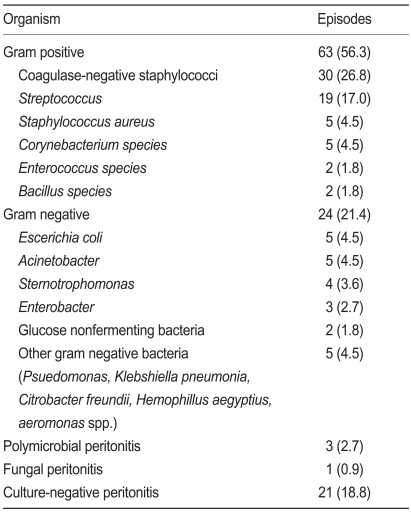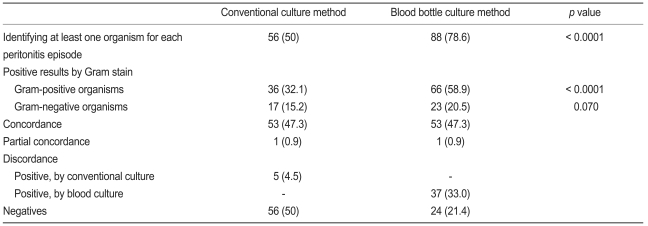Detecting Bacterial Growth in Continuous Ambulatory Peritoneal Dialysis Effluent Using Two Culture Methods
Article information
Abstract
Background/Aims
The aim of this study was to evaluate the peritonitis-causing bacteria detected in peritoneal fluid using a blood culture bottle in patients undergoing continuous ambulatory peritoneal dialysis (CAPD).
Methods
One-hundred and eleven dialysates from 43 patients suspected of peritonitis related to CAPD were retrospectively evaluated between May 2000 and February 2008. In all cases, 5 to 10 mL of dialysate was inoculated into a pair of BacT/Alert blood culture bottles, and 50 mL of centrifuged dialysate was simultaneously inoculated into a solid culture media for conventional culture. The results were compared to those of the conventional culture method. Isolated microorganisms were compared between the two methods.
Results
The blood culture method was positive in 78.6% (88 / 112) of dialysate specimens and the conventional culture method in 50% (56 / 112, p < 0.001).
Conclusions
The blood culture method using the BacT/Alert system is useful for culturing dialysates and improves the positive culture rate in patients with suspected peritonitis compared to the conventional culture method.
INTRODUCTION
Continuous ambulatory peritoneal dialysis (CAPD) is an important form of dialysis treatment for patients with end-stage renal disease as compared to hemodialysis. The major complication of CAPD is peritonitis, which accounts for significant antibiotic use in patients undergoing peritoneal dialysis. According to the International Society for Peritoneal Dialysis (ISPD) and the contemporary treatment guidelines [1-3], antibiotic therapy should be adjusted based on the Gram stain or culture results after empiric initial therapy for peritoneal dialysis-related peritonitis. Prolonged and unnecessary broad antibiotic exposure poses serious concerns due to the significant potential for inducing and selecting resistance, as well as for susceptibility to antibiotic toxicities and fungal peritonitis. Therefore, a definitive microbiological diagnosis and an appropriate adjustment to therapy are important [4].
According to the current ISPD guidelines, the centrifuged sediment of peritoneal effluent is recommended to be inoculated on both solid culture media and blood culture (BC) medium, and if equipment for centrifuging large volumes of fluid is not available, BC bottles can be directly infected with 5 to 10 mL of effluent [2]. Many reports support the advantage of the BC method over the conventional culture (CC) method [5-12]. However, the CC method is still used as the priority method for isolating bacteria in CAPD peritonitis in many hospitals.
The aim of this study was to determine how effective the BC method is for culturing CAPD effluent compared to the current method of culturing concentrated CAPD effluent in solid media.
METHODS
The dialysates of patients suspected of having CAPD peritonitis based on clinical signs and symptoms (abdominal pain with or without fever and peritoneal signs and/or cloudy fluid) between May 2000 and February 2008 were included in this study. We reviewed all of the peritonitis cases during the study period and excluded cases that were not cultured simultaneously by both the BC and CC methods. Specimens were aseptically obtained from the drained effluent bag. Dialysate (5 to 10 mL) was inoculated into one aerobic and one anaerobic BacT/Alert BC bottle at bedside and transported to the microbiology laboratory. Additionally, 50 mL of dialysate was transported to the laboratory in a sterile container. The 50 mL of dialysate was centrifuged at 3,000 g for 15 minutes, and the sediment was used for the CC method. The CC method included inoculating the centrifuged sediment onto 5% sheep's blood, MacConkey agar, and thioglycollated broth, which were incubated at 35℃. The plates were examined after 24 and 48 hours, and the broth was kept for 5 days and examined for growth daily. The isolated organisms were identified and susceptibility testing was performed using the VITEK test card (BioMerieux Vitek, Inc., Hazelwood, MO, USA). The BC method was performed using 5 - 10 mL of peritoneal dialysis effluent inoculated into aerobic and anaerobic BacT/Alert bottles (Organon Teknika Inc., Scarborough, Ontario, Canada), following the manufacturer's instructions. Both bottles were then incubated in the BacT/Alert system at 36℃ with continuous agitation and monitoring for 5 days. The broth was aspirated for Gram staining when bacterial growth was detected by CO2 production. The broth was then subcultured on 5% sheep's blood and chocolate agars and incubated at 35℃ in 5% CO2 for 2 days. The resulting bacteria were identified by the VITEK test card.
The statistical analysis was performed with SPSS for Windows version 10 (SPSS Inc., Chicago, IL, USA). The final reporting statistical comparisons were performed using the paired Student's t-test, and comparisons of the percentages between groups were made with the McNemar test. The level of significance was 0.05.
RESULTS
Organisms from the 112 episodes of peritonitis were isolated using both the BacT/Alert BC bottle method and the conventional centrifugation culture method from May 2000 to February 2008. All cases met the diagnostic criteria for peritonitis. None of the patients were on antibiotics at the time of specimen collection.
Characteristics of isolated bacteria from CAPD fluid
The microbiological characteristics of the peritonitis episodes are listed in Table 1. Using both the BC and CC methods, 81.2% positive cultures were detected. In this series, Gram-positive bacteria were predominant in patients over Gram-negative bacteria (56.3% and 21.4%, respectively). The most common Gram-positive organism was coagulase-negative Staphylococcus, which was detected in 30 of the peritonitis cases (26.8%). Others were Streptococcus species in 19 of the cases (17.0%), Staphylococcus aureus in six (17%), and Corynebacterium species in five (4.5%). The most common Gram-negative organisms were Escherichia coli and Acinetobacter species, which were detected in five cases each (4.5%), and others were Stenotrophomonas species in four cases (3.6%) and Enterobacter in three (2.7%) (Table 1).
Positive rates using the two culture methods
The BC method detected 88/122 (78.6%) positive cultures and the CC method detected 56/112 (50%) (p < 0.0001). The Gram-positive bacteria positive rate was 58.9% (66 / 112) using the BC method and 32.1% (36 / 112) using the CC method (p < 0.0001). The Gram-negative bacteria positive rate was 20.5% (23 / 112) for the BC method and 15.2% (17 / 112) for the CC method (p = 0.07). Of the 112 patients, results from 53 (47.3%) agreed for both methods, whereas 1 / 112 (0.9%) partially agreed. In this case, Streptococcus was isolated using both methods and Pseudomonas was isolated by the BC method only. Thirty-four percent (38 / 112) of the bacterial species were isolated with the BC method only, and the majority were Gram-positive bacteria such as Streptococcus species (12 / 112) and coagulase-negative Staphylococcus (11 / 112), while five (5 / 112) Gram-negative bacterial species were isolated with the CC method group. Yeast, Enterococcus, Streptococcus, and coagulase-negative Staphylococcus were cultured only by the CC method (Table 2).
DISCUSSION
This study showed that microbiological culture rates improved significantly using the BC rather than the CC method. The sensitivities of the BC method and the CC method were 78.6% and 50%, respectively. The range of organisms detected was similar to those reported in previous studies, with Gram-positive organisms dominating (61 / 112, 54.5%). In 1982, Kammerer et al. [5] introduced the BC method to diagnose CAPD peritonitis. In the same year, Luce et al. [6] showed that the incidence of culture negative peritonitis could be reduced from 22% to 4% using the BC method. Since then, many other studies have supported these results [7,8].
Several other methods have been used to improve the sensitivity of culturing dialysates. These methods include centrifugation, filtration, enrichment procedures, large-volume culture, and phagocytic cell lysis. However, some of these methods are time-consuming and require considerable specimen manipulation [9-12]. The advantages of the BC method using the BacT/Alert system include noninvasive monitoring, earlier detection of microbial growth, and decreased technologist manipulation [13].
Several studies have reported on using the BC culturing method for patients with spontaneous bacterial peritonitis, but published data on its use for culturing dialysate from patients with CAPD peritonitis are lacking in Korea [14-17].
Several possible explanations exist for the advantages of the BC method. The sodium polyanethol sulfonate present in the BC bottles acts as an anticoagulant and provides antiphagocytic activity to the culture medium, which may be significant [18]. The direct inoculation of dialysate in the BC method may also reduce the bacterial death and contamination rate. In the CC method, bacteria may die because of delayed inoculation and the continued endogenous antimicrobial activity of the ascetic fluid. Another advantage of the BC method is the reduced time to initially detect a positive culture because the BC bottles are continuously monitored by the BacT/Alert instrument. The BacT/Alert system is a continuous monitoring blood culture system that uses colorimetry to detect CO2 production.
The difference in the Gram-negative organism detection rates for the BC and CC methods was not significant (p = 0.070). However, the total number of Gram-negative organisms was low (24), and 23 Gram-negative organisms were detected by the BC method. Only one Gram-negative organism was missed by the BC method, whereas seven Gram-negative organisms were missed by the CC method.
In this study, the BC method failed to identify yeast. One study reported that the BacT/Alert system failed to detect a significant number of fungemia episodes with the use of BC bottles [19]. This may have been due either to a failure of the medium to support the growth of such fungi or the failure of the computer-generated algorithms of the instrument to detect such growth even when it was present [20].
We use the simple dialysate effluent for the BC media rather than the centrifuged effluent because using centrifuged effluent is a complicated procedure and because of the limitations of a retrospective study.
In summary, although it may have limitations for fungus detection, the direct inoculation of peritoneal fluid into a BC bottle improves the positive culture rate in patients with suspected peritonitis compared to the CC method. Thus, the BC method allows for an earlier appropriate antibiotic treatment and reduces unnecessary antibiotic toxicity.
Notes
No potential conflict of interest relevant to this article was reported.

